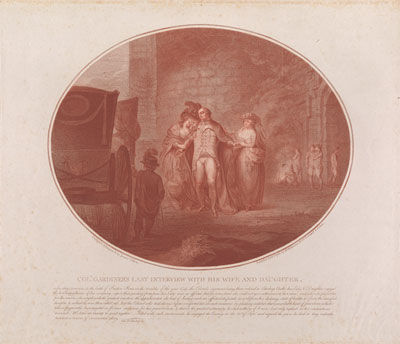Col. Gardiner's Last Interview with his Wife and Daughter
Completely designed and engraved by Gillray, Col. Gardiner's Last Interview with his Wife and Daughter is one of those prints to which Gillray devoted considerable time and effort in the hopes of establishing his reputation as a "serious" artist/engraver. The scene is based on the account in the The Life of Col. James Gardiner, Who Was Slain at the Battle of PrestonPans, September 21, 1745 written by the Non-Conformist Minister Philip Doddridge. Gillray's caption, as he indicates ("Vide Doddridge") is loosely based on the first paragraph of Chapter XV.

[February 1, 1786]
© Yale University Library
Here is Doddridge's text.
It was in that castle [Stirling] that [Gardiner's] lady and eldest daughter enjoyed the last happy hours of his company, and I think it was about ten or twelve days before his death that he parted from them there. A remarkable circumstance attended that parting, which has been touched upon by surviving friends in more than one of their letters to me. His lady was so affected when she took her last leave of him, that she could not forbear bursting out into a flood of tears, with other marks of unusual emotion; and when he asked her the reason, she urged as a sufficient apology, the apprehension she had of losing such an invaluable friend, amidst the dangers to which he was then called out. On this she took particular notice, that whereas he had generally comforted her on such occasions by pleading with her that remarkable hand of Providence which had so frequently in former instances been exerted for his preservation, and that in the greatest extremity, he said nothing of it now; but only replied in his sententious manner, "We have an eternity to spend together."
And here is Gillray's caption based on Doddridge written as a greatly extended title.
Col. Gardiner's Last Interview with his Wife and Daughter a few days prior to the battle of Preston-Pans, in the troubles of 1745, the Colonel's Regiment then being ordered to Stirling Castle, his Lady & Daughter enjoyed the last happy hours of his company; upon their parting from him, his Lady was so affected, that for some time she could not give utterance to her ideas, and when he pressed her for the reason, she urged with the greatest emotion, the apprehension she had of losing such an affectionate friend, as well from his declining state of health, as from the manifest dangers to which he was then called out; but the Colonel who had always before comforted her on such occasions, by pleading with her that remarkable hand of providence which had so frequently been exerted in former instances for his preservation, & that in the greatest extremity, he said nothing of it now, but only replied, in his sententious manner, "We have an eternity to spend together."— Filled with such sentiments, he engaged the Enemy on the 21st of Septr, and acquir'd the prize he had so long ardently pursued, a crown of immortal glory.
Gillray heightens the emotion of an already charged moment by setting the scene outside Stirling Castle in the semi-darkness of a chilly evening with the carriage already waiting with open door to take Colonel Gardiner away. He portrays the Colonel as calm and resigned, an almost Christ-like figure, standing between his weeping wife and daughter. And he reminds us of the battle to come by the presence of soldier/sentinels in the background, one of whom points to the affecting scene.
Sentimental and dramatic prints like this were popular with 18th century audiences. Two years earlier, in 1784, Gillray had created a strikingly accomplished piece called The Village Train (also published by Wilkinson) illustrating lines from Oliver Goldsmith's The Deserted Village. Like that print, Col. Gardiner's Last Interview is generally larger in size (20x16 inches) than Gillray's typical satiric prints. And it announces its "seriousness" not only by its sentimental subject but by using an oval format and more expensive vermillion ink.
But Gillray is likely to have been drawn to the subject of Colonel Gardiner not only because of its heroic story-line (at least as as it was related by Doddridge). There was also a personal connnection through his father. Both Gillray Senior and Gardiner belonged to evangelical sects—Gillray's father a Moravian and Gardiner a Congregationlist. Even more importantly, both Gillray Senior and Gardiner were part of the the 7th Queen's Dragoons under Sir John Cope, and had Gillray Senior not lost an arm at Fontenoy, he would likely have been at Preston Pans alongside Gardiner.
Sources and Reading
- Commentary from the British Museum on Col. Gardiner's Last Interview with his Wife and Daughter.
- Draper Hill, Mr. Gillray The Caricaturist, 1965, p. 27n
- "James Gardiner (British Army officer)," Wikipedia
- "Philip Doddridge," Wikipedia
- P. Doddridge, D.D. THE LIFE OF COL. JAMES GARDINER, Chapter XV.
- "Battle of Prestonpans," Wikipedia
- Thomas Wright and Joseph Grego, The Works of James Gillray, the Caricaturist; With the History of His Life and Times, p. 372.
Comments & Corrections
NOTE: Comments and/or corrections are always appreciated. To make that easier, I have included a form below that you can use. I promise never to share any of the info provided without your express permission.